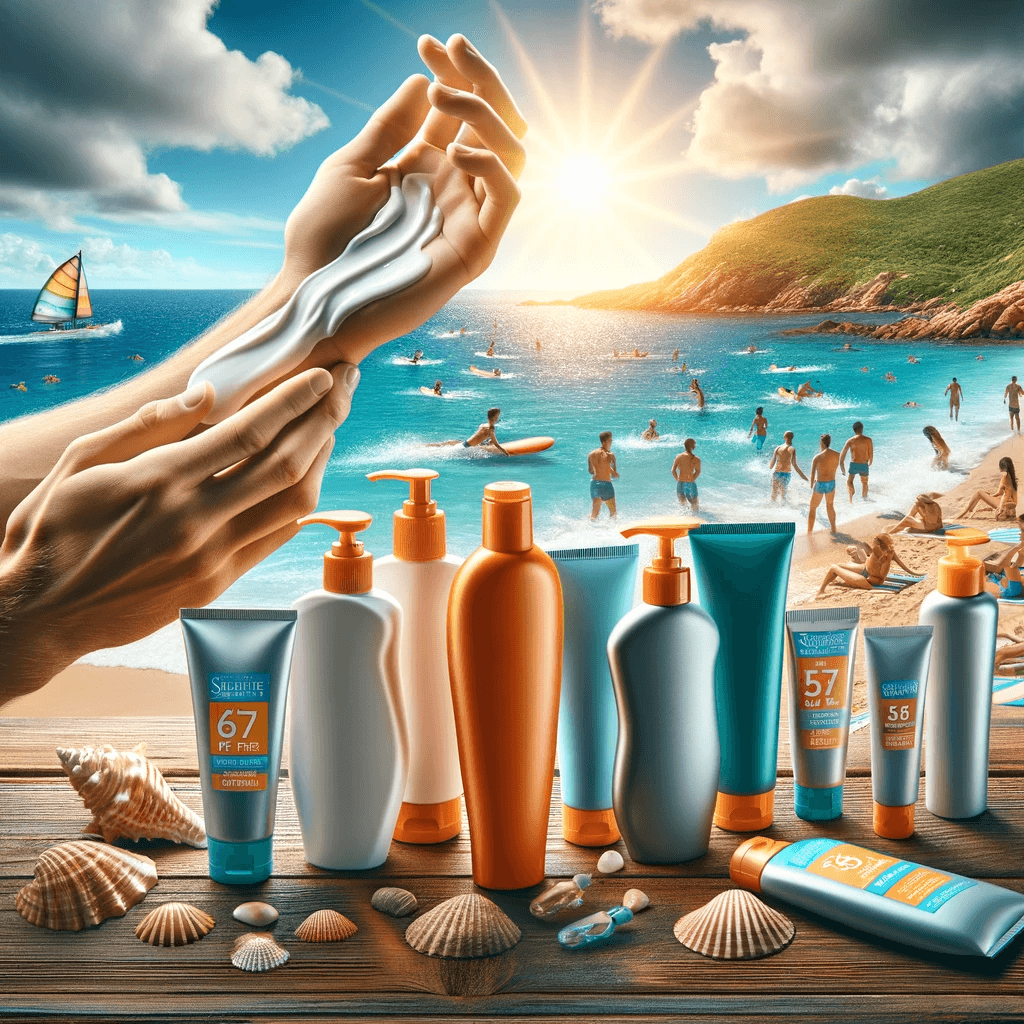Hello there, sun-loving adventurers! As we dive into the world of water activities, it’s crucial to remember that sun protection is not just reserved for the sandy shores. Whether you’re swimming, surfing, or engaging in any water-based escapades, safeguarding your skin from the sun’s harmful rays should be a top priority. In this blog post, we’ll explore the importance of sunscreen during water activities and provide you with valuable tips to ensure you stay protected while having a splashing good time.
Table of Contents
Understanding the Sun’s Impact on Water
When you’re engaging in water activities, whether it’s swimming, surfing, or paddleboarding, it’s important to understand the unique impact the sun can have on your skin. The combination of water and sunlight creates a potential risk for increased sun exposure and its harmful effects. Let’s dive deeper into the factors that contribute to the sun’s impact on water and how it can affect your skin.
- Reflection and Intensified UV Radiation: When sunlight hits the water’s surface, it undergoes a process known as reflection. This reflection can significantly intensify the amount of UV radiation that reaches your skin. In fact, studies have shown that water can reflect up to 80% of the sun’s UV rays, leading to an increased risk of sunburns and skin damage.
- Penetration of UV Rays: UV radiation has the ability to penetrate the water surface, reaching various depths depending on water clarity. While the top layer of water may absorb and scatter some UV rays, a significant portion can still penetrate deeper. This means that even when you’re submerged in the water, your skin is still exposed to UV radiation, making sun protection essential.
- Incomplete Protection from Water: It’s a common misconception that water alone can provide sufficient sun protection. While water can act as a physical barrier and offer some degree of protection, it is not enough to shield your skin entirely from the sun’s harmful rays. UV rays can still penetrate the water and reach your skin, especially in areas where the water is shallow or turbulent.
- Increased Risk of Sunburns: Spending extended periods in the water without proper sun protection can increase your risk of sunburns. The combination of intensified UV radiation and the cooling effect of the water can deceive you into thinking that you’re not getting burned. However, the damage is still occurring beneath the water’s surface, putting you at risk of painful sunburns and long-term skin damage.
To ensure your skin stays healthy and protected during water activities, it’s crucial to take proactive measures and prioritize sun protection. In the following sections, we’ll discuss the importance of choosing the right water-resistant sunscreen, proper application techniques, and sun protection gear to help you enjoy your water adventures while keeping your skin safe from the sun’s harmful effects.
Remember, understanding the sun’s impact on water is the first step towards effective sun protection. By being aware of the unique challenges posed by water activities, you can make informed decisions and take the necessary precautions to safeguard your skin. So, before you hit the waves or dive into the pool, equip yourself with the knowledge and tools to enjoy the water while keeping your skin healthy and radiant.
Choosing the Right Water-Resistant Sunscreen

When it comes to water activities, not all sunscreens are created equal. To ensure optimal sun protection while you’re swimming, surfing, or participating in other water-based sports, it’s crucial to choose a sunscreen specifically designed for water resistance. Here are some factors to consider when selecting the right water-resistant sunscreen:
- Broad Spectrum Protection: Look for a sunscreen that offers broad-spectrum protection, meaning it protects against both UVA and UVB rays. UVA rays can penetrate deep into the skin, leading to premature aging and skin damage, while UVB rays are responsible for sunburns. A broad-spectrum sunscreen shields your skin from both types of UV radiation, providing comprehensive sun protection.
- High SPF: Opt for a sunscreen with a high sun protection factor (SPF) to ensure adequate protection against UVB rays. The SPF number indicates how long it takes for your skin to burn compared to when it’s unprotected. For water activities, choose a sunscreen with an SPF of 30 or higher for extended periods of sun exposure.
- Water Resistance: Check the sunscreen label for the term “water-resistant.” Water-resistant sunscreens are formulated to maintain their effectiveness even when in contact with water or sweat. Look for sunscreens that are labeled “water-resistant for 80 minutes” or “water-resistant for 40 minutes,” indicating the duration of water resistance before reapplication is necessary.
- Skin Compatibility: Consider your skin type and any specific sensitivities when choosing a water-resistant sunscreen. If you have sensitive skin, look for sunscreens labeled as hypoallergenic or formulated for sensitive skin. Non-comedogenic options are also beneficial for individuals prone to clogged pores or acne.
- Application Convenience: Opt for a sunscreen that is easy to apply and convenient for water activities. Choose options that come in spray, lotion, or stick form, depending on your preference. Consider factors such as portability, ease of reapplication, and compatibility with other skincare products or makeup if applicable.
- Reef-Safe Formulations: If you’ll be engaging in water activities in coral reef ecosystems, it’s essential to choose reef-safe sunscreens. Reef-safe formulations are free from harmful chemicals like oxybenzone and octinoxate, which can contribute to coral bleaching and damage marine life. Look for sunscreens that are labeled as reef-friendly or reef-safe to minimize your environmental impact.
Sun Protection Gear for Water Activities
In addition to applying sunscreen, incorporating sun protection gear into your water activities can provide an extra layer of defense against harmful UV rays. Here are some essential sun protection gear items to consider for your next aquatic adventure:
- Rash Guards: Rash guards are long-sleeved swim shirts made from UV-protective fabric. They offer excellent coverage and UPF (Ultraviolet Protection Factor) to shield your arms, torso, and back from the sun. Look for rash guards with a high UPF rating to ensure maximum sun protection.
- Swim Hats: A wide-brimmed swim hat or a hat with a built-in UPF fabric can provide shade and protect your face, neck, and ears from direct sun exposure. Choose a hat with a brim that extends all around the head for optimal coverage. Consider hats made from quick-drying materials to stay comfortable in and out of the water.
- Sunglasses: Protecting your eyes from the sun is just as important as shielding your skin. Invest in a pair of sunglasses with UV protection to block both UVA and UVB rays. Look for sunglasses that wrap around the sides of your face to minimize sun exposure from different angles.
- Swim Goggles with UV Protection: If you’ll be spending a lot of time in the water, consider using swim goggles with built-in UV protection. These goggles not only protect your eyes from chlorine and saltwater but also block harmful UV rays that can penetrate the delicate skin around your eyes.
- Water Shoes: When engaging in water activities, it’s important to protect your feet from sharp objects, hot surfaces, or potential sunburn. Opt for water shoes or aqua socks that provide both comfort and protection. Look for shoes with non-slip soles to prevent accidents on slippery surfaces.
- Beach Umbrella or Tent: If you’re planning to spend a significant amount of time on the beach or by the water, consider bringing a portable beach umbrella or tent. These provide shade and create a designated sun-safe area where you can relax and take breaks from direct sunlight.
- UV-Protective Swimwear: Look for swimwear specifically designed with UPF fabric to provide additional sun protection. UV-protective swimwear covers more skin than traditional swimsuits, reducing sun exposure and minimizing the need for excessive sunscreen application.
- Cooling Towels: Stay cool and protected with cooling towels that provide instant relief from the heat. These towels can be soaked in water and draped around your neck or over your head to help regulate body temperature during hot outdoor activities.
Remember, combining multiple layers of sun protection gear along with sunscreen will give you the best defense against the sun’s harmful rays. Choose gear that fits well, offers the necessary coverage, and is suitable for your specific water activity. Don’t forget to reapply sunscreen to exposed areas not covered by sun protection gear, such as the hands, feet, and face.
Addressing Common Concerns
When it comes to sunscreen and water activities, there are some common concerns that people may have. Let’s address these concerns and provide some guidance to help you make informed decisions:
- Will sunscreen wash off in the water? While water-resistant sunscreens are designed to stay effective for a certain period of time in the water, it’s important to note that they are not completely waterproof. Extended time in the water, excessive sweating, or towel drying can reduce the effectiveness of sunscreen. To maintain protection, reapply sunscreen according to the product’s instructions, especially after swimming or toweling off.
- Does chlorine or saltwater affect sunscreen? Chlorine and saltwater can potentially break down sunscreen over time, especially if you spend long hours in the pool or ocean. To ensure optimal protection, choose a water-resistant sunscreen with a high SPF and reapply regularly, as recommended. Additionally, rinsing off with fresh water after swimming can help remove any residual chlorine or saltwater from your skin.
- Can sunscreen cause harm to aquatic life? Some chemical sunscreen ingredients, such as oxybenzone and octinoxate, have been associated with potential harm to coral reefs and other marine life. If you’ll be swimming in sensitive aquatic environments, consider using reef-safe or mineral-based sunscreens that do not contain these ingredients. Look for sunscreens labeled as “reef-friendly” or “ocean-friendly.”
- What if I prefer to use natural alternatives to sunscreen? While natural alternatives like coconut oil or shea butter may offer some level of sun protection, they do not provide the same level of broad-spectrum coverage as sunscreen. If you choose to use natural alternatives, understand that they may not offer adequate protection against both UVA and UVB rays. It’s always advisable to use a sunscreen product with a proven SPF rating to ensure sufficient protection.
- Can I wear makeup over sunscreen while engaging in water activities? While it’s possible to wear makeup over sunscreen, keep in mind that water activities may cause makeup to smear or wash off. If you prefer to wear makeup while swimming or engaging in water activities, opt for waterproof or water-resistant products. Additionally, consider using a lightweight, tinted sunscreen that can act as a base and provide some coverage while protecting your skin.
Conclusion
With the sun, sand, and water calling your name, it’s important to prioritize sun protection during your water activities. By incorporating the right sunscreen, applying it correctly, and complementing it with sun-protective gear, you can enjoy your aquatic adventures with peace of mind. So, dive in, ride the waves, and let the sun be your friend, not your foe.
Remember, staying protected under the sun is crucial not only for the health and youthfulness of your skin but also for your overall well-being. So, next time you embark on a water-filled escapade, make sure to bring your sunscreen along and soak up the fun while keeping your skin safeguarded.
